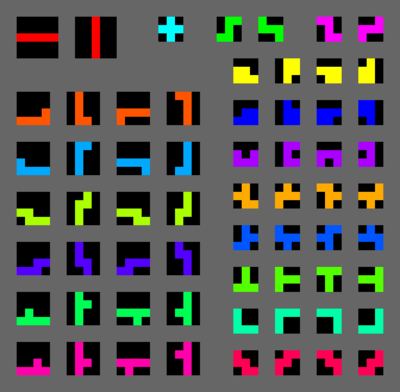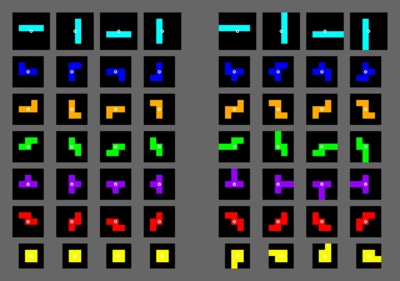A Gnowius' Challenge
| A Gnowius' Challenge | |
|---|---|
Thumbnail for the A Gnowius' Challenge itch.io page. | |
| Developer(s) | Oshisaure |
| Platform(s) | Windows, macOS, Linux |
| Release | Apr. 2018 |
| Gameplay info | |
| Next pieces | 1 to 15 |
| Playfield size | 4 × 4 to 99 × 99 |
| Hold piece | Yes, with IHS |
| Hard drop | Yes (Sonic Drop) |
| Rotation system | Various, some custom |
A Gnowius' Challenge is a fan game created by Oshisaure using Love2D. While the development of the game is currently discontinued, a demo has been released and is available.
Gameplay
The game consists of two game modes: the main mission mode and a practice sandbox.
Mission mode
The main mode of the game makes you go through stages and asks you to complete certain tasks, similarly to Tetris The Grand Master Ace's Tetris Road. So far, 20 stages have been made.
It should be noted that the game uses immobile spin detection, instead of guideline's 3-corner. This is especially important for stages requiring spin line clears.
| Stage | Goal | Gimmicks / Notes | Rotation System |
Gravity (G) |
ARE (frames) |
Line ARE (frames) |
Line clear (frames) |
DAS (frames) |
Lock (frames) |
|---|---|---|---|---|---|---|---|---|---|
| 1 | Clear a line. | Super | 1/64 | 30 | 20 | 20 | 15 | 60 | |
| 2 | Clear a line. | Arika | 1/64 | 30 | 20 | 20 | 15 | 60 | |
| 3 | Clear 4 lines at once. | Arika | 1/64 | 30 | 20 | 20 | 15 | 60 | |
| 4 | Clear a T-Spin line clear. | Super | 1/64 | 30 | 20 | 20 | 15 | 60 | |
| 5 | Recover to the bottom. | Stage spawns with a preset map. | Super | 1/64 | 30 | 20 | 20 | 15 | 60 |
| 6 | Clear 4 lines at once twice in a row. | Game not only expects a Back-to-Back, but a combo. | Arika | 1/64 | 30 | 20 | 20 | 15 | 60 |
| 7 | Survive. | This is basically TGM speed curve from Lv200 to Lv299. | Super | 1/64 → 1 | 30 | 20 | 21 | 14 | 30 |
| 8 | Survive 30 seconds of max. gravity. | Arika | ∞ | 30 | 20 | 21 | 14 | 30 | |
| 9 | Clear 10 lines in max. gravity. | Super | ∞ | 30 | 20 | 21 | 14 | 30 | |
| 10 | Survive in max. gravity. | This is basically TGM speed curve from Lv500 to Lv599. | Arika | ∞ | 30 | 20 | 21 | 14 | 30 |
| 11 | Clear 10 T-Spin lines. | Super | 1/32 | 30 | 15 | 15 | 12 | 45 | |
| 12 | Clear 20 lines. | Field is 5 × 10, simulating big mode. | Arika | 1/64 | 30 | 15 | 15 | 12 | 30 |
| 13 | Clear 5 lines. | Field is 20 × 40, simulating the opposite of big mode. | Super | 1/8 | 30 | 15 | 15 | 12 | 30 |
| 14 | Clear 10 lines. | Field is displayed upside-down. | Super | 1/16 | 30 | 15 | 15 | 12 | 30 |
| 15 | Clear 10 lines. | Pieces rotate by themselves every half second. | Arika | 1/128 | 30 | 15 | 15 | 12 | 30 |
| 16 | Clear 10 lines. | Field display rotates 90° every half second. | Arika | 1/128 | 30 | 15 | 15 | 12 | 30 |
| 17 | Clear 10 lines. | Shirase | 1 | 30 | 15 | 15 | 12 | 30 | |
| 18 | Clear 10 lines. | Transform | 1/30 | 30 | 15 | 15 | 12 | 30 | |
| 19 | Clear 10 lines. | Pento | 1/64 | 30 | 15 | 15 | 12 | 30 | |
| 20 | Clear 5 I-spin Quadruples. | BONKERS | 1/64 | 30 | 15 | 15 | 12 | 30 |
Practice Sandbox
This mode lets you play under custom settings, with no goal and no time limit, until you either top out or back out. You can also left-click the matrix to place blocks, and right-click to remove them. This is meant as a practice tool to train specific timings and/or Rotation Systems.
The settings you can change are the following:
- Field rows: Width of the field in cells, between 4 and 99.
- Field columns: Height of the field in cells, between 4 and 99.
- Rotation System: The rotation rules in place. See below for more information.
- Next Previews: Length of the next queue, between 1 and 15.
- Blocksize: Size of the blocks in pixels, between 1px and 64px.
- Field angle: Angle at which the field is displayed, between 0° and 360° in steps of 22.5°.
- Field depth: Scale of the back layer display of the field giving the 3D effect. This is purely graphical.
- Gravity: Speed of the blocks' fall in rows per frame (G). You can set the numerator and the denominator separately. Setting the denominator to 0 results in infinite gravity.
- Delayed AutoShift: Delay in frames before DAS kicks in.
- Lock Delay: Time in frames before your piece locks. Note that this game does not have move reset, only step reset.
- Spawn Delay (ARE): Time in frames between a piece lock and the next piece spawn.
- Line Clear Delay: Time in frames between a piece lock and the clearing of a line is complete.
- ARE after Line Clear: Time in frames between the end of a line clear and the next piece spawn.
Note that changing field dimensions, rotation system, next previews or blocksize will reset the whole board, erasing the previous map drawn and resetting the piece sequence.
Rotation Systems
Alongside the Super Rotation System and the Arika Rotation System, the game has a few more Rotation Systems that can be used in the practice sandbox.
Using Tetromino pieces
Shirase Rotation System

Shirase Rotation System (abbreviated ShiRS) was originally a mock-up of SRS made by Makiki in NullpoMino's ruleset editor.
It is based on regular SRS, but the base rotations are shifted so that the axis of rotation appears one block more towards the left when comparing with the piece facing up. The offset data for wallkicks is the same as standard SRS, but applied to these new base positions.
This leads to a lot of questionable shenanigans, like O-Spin, I-Spin Tetrises, or pretty much every piece gaining the ability to warp.
Texmaster World Rule
As the name implies, Texmaster World Rule (abbreviated TexyWorld) is based on Texmaster's implementation of World Rule.
Here, it is exactly the same as SRS for clockwise rotations, but counter-clockwise rotations see their offset data mirrored left to right.
This makes twists like these possible:
Rotate CCW |
Check 1 |
Check 2 |
Check 3 |
Check 4 |
Check 5 works |
T-Spin Triple yay |
There may be differences with the actual World Rule from Texmaster, but this is how this version was implemented.
Transform Rotation System
Transform Rotation System (abbreviated TfRS) is a rotation System based on TGM rotation, but mimicking the Transform effect from the TGM games' items.
Upon rotation, the active piece changes shape to morph into another tetromino picked at random, but keeps its orientation, so for example, morphing from a T piece into an L piece from a left rotation L piece rotated left as well.
While this theoretically has a chance of resulting in some pretty impressive and useful twists, most of the time, the piece will not turn into what you need.
Biased-On-Nutty-Kick-Enhancement Rotation System
Biased-On-Nutty-Kick-Enhancement Rotation System (abbreviated BONKERS) is a rotation system designed by Oshisaure.
If the piece isn't blocked and is in the air, it behaves like SRS base rotations. However, if the piece kicks or was on the ground when rotated, it will take the lowest possible position available, in a 1-cell range left or right.
Examples using a T piece:
Mid-air |
Nothing unusual |
Wallkick |
The lowest position | |||||
Grounded |
The lowest position is prioritised, |
Grounded |
The lowest position less than 2 | |||||
Wallkick |
At the same height, centre has |
Grounded |
At the same height, right |
There is a special case for the I piece where it could get stuck against a border of the matrix. To prevent this, it is moved one cell to the side before looking for a place to go to.
Spawn |
CW rotation |
DAS to wall | |||
CW Rotation, piece is |
Piece is pushed one |
It can now kick back |
This behaviour was implemented with an oversight in A Gnowius' Challenge. It will not work on the right wall in playfields less than 10 cells wide, and the I piece will warp back in column 9 if is to the right of column 9 in playfields wider than 10 cells.
Using the rules defined by this rotation system, it is really easy to make T-Spin Triples or I-Spin Tetrises:
Grounded |
T-Spin Triple! | ||
Grounded |
I-Spin Tetris! |
Using Pentomino pieces
Pentomino Arika-Inspired Rotation System

The Pentomino Arika-Inspired Rotation System (abbreviated PAIRS) is a Pentomino rotation system made by Oshisaure and based, as the name implies, on TGM rotation.
The base rotations are tied to the floor of the bounding box the piece is in, except for the I piece which rotates around its centre. This means that rotating a piece from a flat ground will make it stay on the same flat ground without kicking. This alone already allows for some spins.
CCW rotation |
Spin! | ||||
CW rotation |
Spin! | ||||
CCW rotation |
Spin! | ||||
CW rotation |
Spin! | ||||
Shift and drop |
Rotate CCW |
Spin! |
On top of this, if the base rotation fails, the piece will try to kick right, then left, then two cells right, then two cells left, then one cell up.
| Test 1 | Test 2 | Test 3 | Test 4 | Test 5 | Test 6 |
|---|---|---|---|---|---|
| ( 0, 0) | (+1, 0) | (-1, 0) | (+2, 0) | (-2, 0) | ( 0,+1) |
This allows for more spins, and for the I pentomino to kick off walls, although it should be noted that the I pentomino cannot kick off a flat floor, since it doesn't have a kick 2 cells up. But here are more examples of spins using wallkicks.
CW rotation |
Spin! | ||
CCW rotation |
Spin! | ||
CW rotation |
Spin! | ||
CCW rotation |
Spin! | ||
(C)CW rotation |
Spin! |
Puyo Puyo Tetris' Pentomino Rotation System

As the name implies, Puyo Puyo Tetris' Pentomino Rotation System is based on how Puyo Puyo Tetris handles Pentomino rotations.
When using this rotation system, only 7 pieces are available: I, F, Z, N, W, T, and P. When rotating, the piece rotates just like the original piece under regular SRS rules, but the extra block follows.
While utilizing the same wallkicks as the original one, it also takes the extra block in consideration when checking for collision. This means SRS spin setups can be arranged to accommodate for the new piece. More information on this rotation system can be found here.

